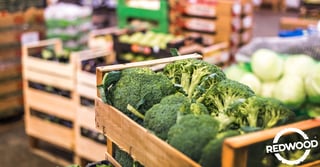REDWOOD LOGIN
Redwood PortalLTL
SCS
SCS Support
Rockfarm


Due to the continued impacts on global supply chains of the pandemic, food shippers are facing the same conundrum many businesses have spent the past several months adjusting to: how to balance production cycles, forecasting, modeling, and estimations while minimizing costs and potential waste in the most turbulent environment in decades. Responding to the markets when dealing with delicate products that can spoil easily when overproduced, and managing the procurement, shipping, and distribution of items like fresh produce and fish requires extremely detailed coordination. Food shippers are doing their best to strike a balance between push and pull strategies in order to achieve this.
Despite the challenges freight and supply companies have faced since the beginning of the pandemic, U.S. supply chain companies have demonstrated that they are still able to deliver products around the country. With unusual side effects across industries, both globally and locally, food shippers and freight companies have needed to respond to additional hurdles while continuing to follow many of the same trends as previous years. For example, the summer season typically sees a dramatic increase in consumer food and beverage demand, and this rise has been seen every year for decades.
Want to learn how you can begin implementing push and pull strategies for your own business? Schedule your free consultation with our team today.
Thanks to the consistencies of some trends, like the summer demand increase, food shippers have been able to rely on forecasting and push strategies as usual to anticipate demand. This is a boon when dealing with seasonal volume increases of certain types of produce that reach peak ripeness and consumer demand during the summer months. However, due to operating constraints and system limitations, demands for some products have fluctuated wildly, and shippers have responded accordingly, operating on a more hybrid model of “push/pull” systems.
While already challenging, the many difficulties of efficiently managing a supply chain are compounded when dealing with fresh produce and other foodstuffs that require temperature control and have short spoilage windows. Coordination issues can be enormous without taking into consideration slowdowns or other issues caused by the pandemic, and with razor-thin profit margins, errors can be severely financially damaging. Waste is already a major concern within the food shipping industry, and utilization of the hybrid model, particularly when implementing the pull aspect, is a way to attempt to reduce waste.
A healthy balance of push and pull (or as it’s more commonly known lean inventory management) allows food shippers to strike a balance between having enough food products on hand to meet customer demand while also minimizing storage, production, and waste costs. The most effective versions of these systems utilize the economic order quantity (EOQ) formula to determine inventory needs and reordering frequencies and use a variety of data points to determine inventory costs and projections. Keeping track of all of these factors and data points requires extreme attention to detail, and calculating them correctly can be very difficult. Inventory management software is a must-have when operating with the push/pull system to avoid errors and time management issues.
One of the best ways of managing the various challenges faced by food and beverage companies during this pandemic is partnering with a logistics provider that can meet on-time delivery needs. With time in transit being such a critical element for food shippers, and many food and beverage companies shipping smaller volumes, there’s a huge increase in pressure to deliver loads much faster as grocery and other distributors wait on products to arrive and stock their stores. Logistics providers can navigate the full-truckload versus less than truckload rates and assure that product is reliably arriving when and where expected. This leaves food shippers to focus on determining demands and deciding where a product is needed while negotiating with suppliers that may be struggling due to decreased labor forces to harvest products. Logistics partners have relationships with a variety of freight services and are able to negotiate LTL (less than truckload) services that are consistent and not simply less expensive.
Utilizing a healthy hybrid model of push and pull strategies to strike a balance in fluctuating demand and availability of products is no easy task, but food shippers are responding to the challenge. The market has continued to behave in some ways as it always has, and despite the strains and hurdles, U.S. supply chains have demonstrated their resilience and flexibility in response to the pandemic.
Stay up to date on all the latest news from Redwood and get tips for your supply chain every month by signing up for our monthly newsletter.